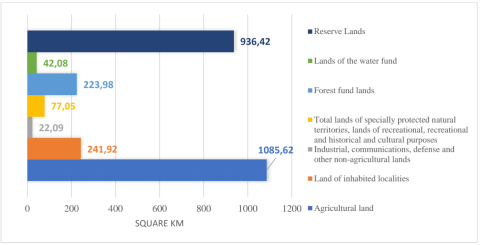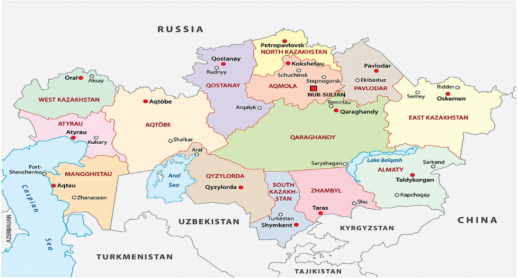This article discusses the main branches of modern agricultural land management and processes of privatization of agricultural land in the country, the degree of market development relations in them. Modern space technologies make a significant contribution to the development of the agro-industrial complex and for the effective use of agricultural land in Kazakhstan. The article analyzes the causes of the problem of land privatization in agriculture and prospects of its solution and points out the need to search for an optimal balance between the social and economic constituents of this problem. During the research, the main ways to implement land privatization in the country with applying the experience of foreign countries are described in detail.
Keywords: agriculture, GIS, land use system, land privatization, space monitoring.
1. The general conditions of agriculture and its main directions
The country's agriculture includes two main sectors — crop production and animal husbandry. They are also divided into several branches, for example, animal husbandry, which can be focused on the production of meat and milk, and cultivation crops. The difference may be related to the types of products, the technical means of production used.
First of all, agricultural industry is the main component of the national economy. This is due to several features and advantages, which include huge land area of the country (see Figure 1), the state's presence among the world's largest exporters of grain and flour, and the growing demand for food products produced by Kazakhstan for neighboring countries (China, Central Asian countries) (Nurbay 2020).

Fig. 1. Distribution of land by category in Kazakhstan, November 1 st , 2020
Source: https://www.gov.kz
The forest-steppe zone in Kazakhstan occupies a small territory with the most productive and stable agricultural production. These lands have specialized in the development of grain and milk production, potatoes, oilseeds. While Akmola region specializes in cultivation, Aktobe region-in crop production and animal husbandry, and East Kazakhstan region-in the cultivation of oilseeds.
In regions with dry weather, livestock and crops are developed. For example, agriculture and livestock are developing in the Akmola region, horses in the East Kazakhstan region, and sheep are growing in the West Kazakhstan region.
In desert regions, sheep farming is mainly practiced. In the Karagandy region, along with sheep, large meat cattle are grown, and in the Mangystau region, sheep and camel farming is mainly developed. Kyzylorda region is the birthplace of rice. However, nature here is also very suitable for breeding sheep, camels, and horses.
The Almaty region is suitable for the cultivation of beets, vegetables, dairy cattle, and poultry, Zhambyl region-for the cultivation of potatoes. Cattle and sheep farming are developed in the Turkistan region, horse breeding and oilseeds cultivation are developed in the East Kazakhstan region.
In addition, the desert region in the Turkestan region is suitable for growing cotton. Vegetables and garden crops, grapes are also grown. In addition, tobacco is grown only in this area of the country.

Fig/ 2. Map of regions of Kazakhstan [Source: https://www.worldatlas.com]
2. T ypes of problems in agricultur e with possible ways to solve them, and definition of land privatization
Currently, one of the main tasks of the Government, also private investors and companies of the Republic of Kazakhstan is to increase the competitiveness of the agro-industrial complex as the main driving force of the national economy. For example, for the further qualitative development of agriculture, it is necessary to increase the level of productivity by replacing old machinery and equipment, introducing modern resource-saving technologies. In addition, to attract young professionals to work in the agricultural sector, it is necessary to continue working on improving living conditions in rural areas (infrastructure, housing, and communal services, benefits, etc.).
One of the possible ways to the improvement of the agricultural industry in the Republic of Kazakhstan is the privatization of agricultural land. The first specifying of agricultural land in private ownership was carried out in the Presidential Decree (1994). The decree laid the foundation for the transfer of agricultural land to private ownership without disrupting the Constitution. It was possible to sell, donate, lease and pledge land through the right of permanent use. However, society was not ready for this. When looking for an answer to why society doesn’t want to support this idea, the public usually concludes that the sale of land is the «sale of the motherland». Ownerless land is an abandoned. In the case of Kazakhstan, the inclusion of land in the market turnover means the inclusion of huge unused resources in the economy. By paragraph 1 of Article 24, Chapter 3 of the Land Code of the Republic of Kazakhstan (2003), “It is not allowed to transfer agricultural land plots to private ownership as state in-kind grants for conducting agricultural production” .
Conducting space monitoring of land makes it possible to create GIS platforms of sown areas of crops based on satellite images, determine the contamination of crops, their specific yield based on ground observations, etc. In addition, it is possible to identify unused areas of agricultural land, as well as determine their quality.
Satellite images are an important, objective source of information on soil degradation. Even in poorly dissected lowland agricultural landscapes, the materials of aerospace surveys make it possible to record subtle manifestations of flushing, localize the areas of activation of the processes of degradation, deflation, and salinization (waterlogging) of arable land, which ensures timely detection of changes of the land, thereby preventing irrational use and the influence of negative factors. In the age of high technology, the yield of land depends not only on the physical characteristics of the land. New methods and technologies used in production have a positive effect on the profitability of land. Therefore, the increase in the area of agricultural land due to the increase in arable land, hayfields, pastures, perennial plantings attract new agricultural producers.
3. Е xperiences of foreign countries in the privatization of land and its applicability in Kazakhstan
When analyzing the legal side of the issue of private land ownership, which became one of the important areas for the improvement of land use in agriculture. The legalization of the issue of granting agricultural land to private ownership and extending the lease term has not yet occurred. Steps 35–36 of the strategic document program “ National plan-100 concrete steps ” of the president of the Republic of Kazakhstan (2015) is dedicated to the ownership and effective use of agricultural land. It says: « Step 35. Introduction of agricultural land into market circulation to effectively use it. Improvements to the Land Code and other legislative acts. Step 36. Simplification of procedures for obtaining permits to change the type of targeted use of land plots. Regular monitoring of the use of agricultural land. Transfer of all unused land to the state fund for further privatization» . In these words, the idea is to improve the land law, which has long been formed, to increase the entry into market circulation through the extension of the lease term and sale of agricultural land in private ownership. Many agricultural lands, due to depersonalization, have not been cultivated for many years, have been invaded by weeds, and are being degraded (Kemel 2016).
If we look at the process of transferring land to private ownership in different countries, in France, the land is transferred to private ownership. Nevertheless, it is forbidden to sell it to another person, it is only possible to rent it.
Privatization in France had a clearly defined fiscal character. The country sold its property at significantly higher prices compared to compensation payments during nationalization. As a result, the state was bailed out by 65.8 billion francs, a significant part of this amount went to repay the public debt (Berne 2004).
In the UK, it is transferred to private ownership, but it is prohibited to sell it to foreign citizens. As a result of large-scale British privatization in the 80s, the scale of the public sector was reduced to 2/3. Britain's experience in the field of privatization has had a direct impact on all sides of the world (Layard 2019) .
Turkmenistan has private ownership of state-owned and unused land. Today, 10 % of the land is privately owned (Kemel 2019).
In Uzbekistan, private property is transferred only for construction (Kemel 2019).
The implementation of land privatization regarding the experience of foreign countries can be applied in Kazakhstan by following recommendations:
– Despite the priority of agriculture in our country, there are still vast territories of empty lands that were once actively used. To involve such lands in agricultural turnover, it is necessary to revise land legislation and introduce a classification of the suitability of agricultural land based on GIS technologies. It is necessary to raise the quality of GIS education, provide universities with an appropriate GIS material base, conduct training and certification of teachers.
– It is essential to create a group on TV channels, radio, social networks, and at meetings in regional centers, university teaching base to explain the process of formation of land ownership and lease and the rules that may continue shortly.
– The Land Reform Commission assigned to the Government of the Republic of Kazakhstan should ensure clarity of all information related to the ownership and use of land, its location, fixed prices, etc.
– The creation of production cooperatives, the unification of small farmers. It is necessary to lay a legal basis for this. For example, it is better to give cooperatives the status of small businesses. They need to know what rights and obligations they have on the legal side. If they were granted the same status within the framework of the law, the issues of their financing and lending would be resolved optimally. Rational use of land is a very relevant issue.
To sum all that has been stated, and compare the advantages and disadvantages of land privatization, we can consider the suggestions and the main conclusion. By selling individual state assets to the private sector, states will be able to turn inactive physical capital into financial capital that can be used for investments in new infrastructure or for tax benefits. Finally, by systematically applying privatization methods to a wide range of public services and assets, policymakers can fully realize the potential of privatization.
References:
- Berne, M., Pogorel, G., 2004. Privatization experiences in France. Cesifo working paper, no. 1195, 2–10.
- Kemel, M. (2016). Problems in land relations [online]. Available from: — https://qazaquni.kz/basty-makalalar/51667-zher-katynastarynda-t-ytkildi-zhaytta
- Land Code of the Republic of Kazakhstan, (2003). Right of ownership of agricultural land, Chapter 3, Article 24, paragraph 1 [online]. Available from: — — https://adilet.zan.kz/kaz/docs/K030000442_
- Layard, A., 2019. Privatizing land in England. Journal of Property, Planning and Environmental Law, 11(2), 151–168.
- Nurbay, R., (2020). How agriculture is developing in Kazakhstan [online]. Available from: — https://strategy2050.kz/ru/news/kak-razvivaetsya-selskoe-khozyaystvo-v-kazakhstane/
- Presidential Decree, (1994). On further improvement of land relations [online]. Available from: — https://adilet.zan.kz/kaz
- The strategic document program, (2015). National plan-100 concrete steps [online]. Available from: — https://adilet.zan.kz/kaz/docs/K1500000100







